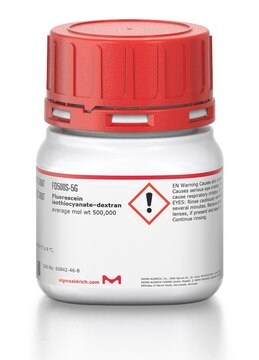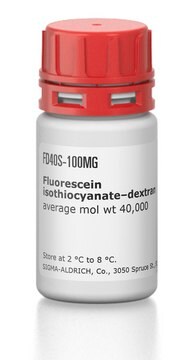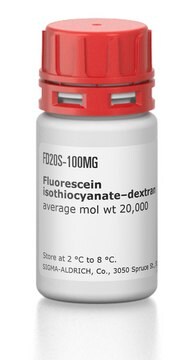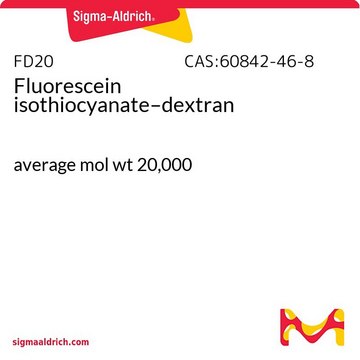FD250S
Destrano marcato con isotiocianato di fluoresceina
average mol wt 250,000
Sinonimo/i:
FITC–destrano
Autenticatiper visualizzare i prezzi riservati alla tua organizzazione & contrattuali
About This Item
Prodotti consigliati
Origine biologica
bacterial (Leuconostoc mesenteroides)
Livello qualitativo
Coniugato
FITC conjugate
Stato
powder
PM
average mol wt 250,000
Grado di funzionalizzazione
0.003-0.020 mol FITC per mol glucose
Colore
yellow to orange
Solubilità
water: 25 mg/mL, clear, yellow
Temperatura di conservazione
2-8°C
Cerchi prodotti simili? Visita Guida al confronto tra prodotti
Descrizione generale
Dextran is a polymer of anhydroglucose. It is composed of approximately 95% alpha-D-(166) linkages. The remaining (163) linkages account for the branching of dextran. Conflicting data on the branch lengths implies that the average branch length is less than three glucose units. However, other methods indicate branches of greater than 50 glucose units exist. Native dextran has been found to have a molecular weight (MW) in the range of 9 million to 500 million. Lower MW dextrans will exhibit slightly less branching and have a more narrow range of MW distribution. Dextrans with MW greater than 10,000 behave as if they are highly branched. As the MW increases, dextran molecules attain greater symmetry. Dextrans with MW of 2,000 to 10,000, exhibit the properties of an expandable coil. At MW below 2,000, dextran is more rod-like. The MW of dextran is measured by one or more of the following methods: low angle laser light scattering, size exclusion chromatography, copper-complexation and anthrone reagent colorometric reducing-end sugar determination and viscosity.
Applicazioni
Destrano marcato con isotiocianato di fluoresceina per il possibile utilizzo negli studi di perfusione negli animali.
FITC-dextran is used extensively in microcirculation and cell permeability research utilizing microfluorimetry. FITC-dextran has been used to study plant cell wall porosity and capillary permeability. Plasma proteins have been shown not to bind to FITC-dextran.
FITC-dextran is used in cardiovascular, microcirculation, perfusion, cell monolayer and cell membrane permeability research as fluorescent flux tracer compound that supports the measurement of processes such as blood flow, membrane damage, vascular drainage and renal elimination. Small FITC-dextrans are also used to measure processes such as endocytosis. FITC-Dextran 250 (FD 250) may be used as a model compound for development of methods to deliver molecules into protoplasts and to study drug release from structures such as hydrogels and liposomes. It may be used as a model compound to study microvasculature and blood brain barrier.
Nota sulla preparazione
Sigma typically tests the solubility of FITC dextrans in water at concentrations at or above 25 mg/ml. Solutions should be protected from light. In vivo, FITC-dextran is stable for more than 24 hours.
Altre note
To gain a comprehensive understanding of our extensive range of Dextrans for your research, we encourage you to visit our Carbohydrates Category page.
Avvertenze
Warning
Indicazioni di pericolo
Consigli di prudenza
Classi di pericolo
Eye Irrit. 2 - Skin Irrit. 2 - STOT SE 3
Organi bersaglio
Respiratory system
Codice della classe di stoccaggio
11 - Combustible Solids
Classe di pericolosità dell'acqua (WGK)
WGK 3
Punto d’infiammabilità (°F)
Not applicable
Punto d’infiammabilità (°C)
Not applicable
Dispositivi di protezione individuale
Eyeshields, Gloves, type N95 (US)
Scegli una delle versioni più recenti:
Possiedi già questo prodotto?
I documenti relativi ai prodotti acquistati recentemente sono disponibili nell’Archivio dei documenti.
I clienti hanno visto anche
Jennifer L Guerriero et al.
Nature, 543(7645), 428-432 (2017-03-09)
Although the main focus of immuno-oncology has been manipulating the adaptive immune system, harnessing both the innate and adaptive arms of the immune system might produce superior tumour reduction and elimination. Tumour-associated macrophages often have net pro-tumour effects, but their
Cerec Omnicam - Intraoralscan 2.0.
K Wiedhahn et al.
International journal of computerized dentistry, 15(3), 199-205 (2012-12-21)
Fabiana Gomes da Conceição et al.
Clinics (Sao Paulo, Brazil), 67(8), 923-929 (2012-09-06)
Ischemic preconditioning and some drugs can protect tissues from injury by preserving microcirculation. This study evaluated vascular permeability in a hamster cheek pouch preparation using either short ischemic periods or bradykinin as preconditioning stimuli followed by 30 min of ischemia/reperfusion.
Cristiana Marcozzi et al.
Regenerative medicine, 15(9), 2085-2098 (2020-11-18)
Aim: The proposal of this study was to evaluate, in vitro, the potential paracrine effect of human adipose-derived stem cells (hASCs) to promote lymphangiogenesis in lymphatic endothelial cells isolated from rat diaphragmatic lymphatic vessels. Materials & methods: ELISA on VEGFA, VEGFC and
Fusanori Yotsumoto et al.
Oncoimmunology, 4(4), e1001204-e1001204 (2015-07-03)
Early stage growth of intracranial B16F10 tumors is reduced by 87% in myeloid-specific NG2 null (Mac-NG2ko) mice and by 77% in pericyte-specific NG2 null (PC-NG2ko) mice, demonstrating the importance of the NG2 proteoglycan in each of these stromal compartments. In
Il team dei nostri ricercatori vanta grande esperienza in tutte le aree della ricerca quali Life Science, scienza dei materiali, sintesi chimica, cromatografia, discipline analitiche, ecc..
Contatta l'Assistenza Tecnica.








